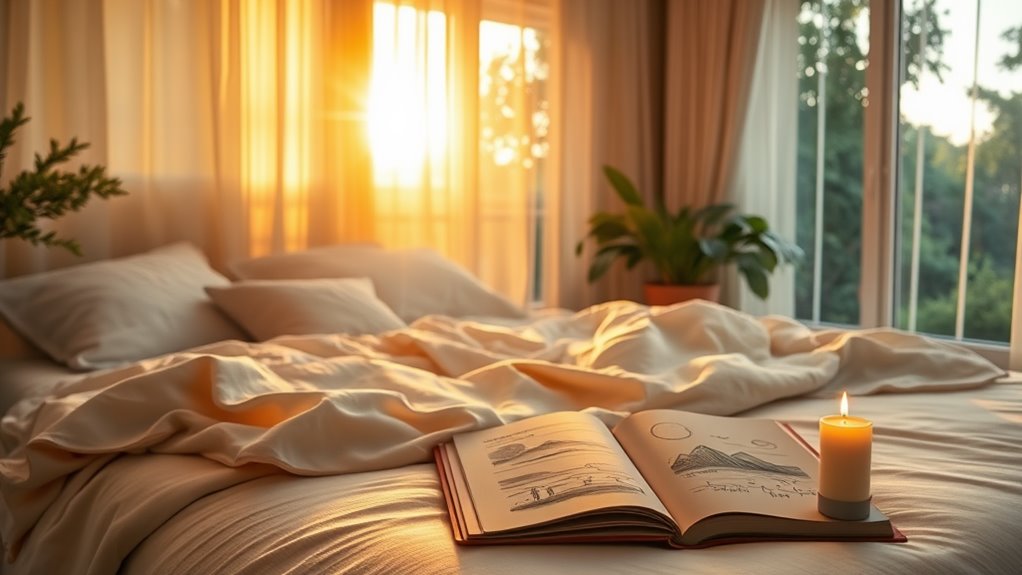Achieve Restful Sleep With Visualization Techniques!
To achieve restful sleep with visualization techniques, create a calming environment and engage your senses. Picture serene landscapes while inhaling deeply and exhaling slowly, letting stress fade away with each breath. Consistently practice this mental imagery each night to improve sleep quality and establish relaxation. Remember, it’s all about finding what works best for you and tracking your progress. There’s so much more you can explore about these powerful techniques for better sleep.
Key Takeaways
- Create a calming sleep environment by dimming lights and reducing disturbances to enhance relaxation during visualization practices.
- Visualize serene landscapes with vivid details to engage your senses and promote a peaceful state of mind.
- Integrate deep breathing with visualization to soothe your nervous system and ground yourself in the present moment.
- Establish a bedtime routine that includes visualization techniques to signal your body it’s time to wind down.
- Track your sleep quality in a journal to evaluate the effectiveness of visualization and adapt strategies as needed.
Understanding the Importance of Sleep
Sleep is essential for your overall health and well-being, as it plays an important role in restoring your body and mind. To achieve restful sleep, you need to understand its significance.
Quality sleep enhances cognitive function, emotional stability, and physical recovery, allowing you to perform at your best. When you consistently prioritize restful sleep, you equip yourself with the mental clarity to tackle challenges, the energy to execute tasks, and the resilience to cope with stress.
Neglecting sleep, on the other hand, can lead to impaired judgment, decreased productivity, and various health issues. Emphasizing the importance of restorative sleep in your life is critical: it’s not just a luxury; it’s a cornerstone of peak performance and well-being. Incorporating techniques such as visualization techniques can further enhance your ability to achieve deep, restorative sleep.
How Visualization Techniques Work
Visualization techniques harness the power of mental imagery to create a calming environment for your mind. By focusing on serene images or scenarios, you activate your relaxation response, helping to ease stress and prepare for sleep. This process not only promotes restfulness but also enhances the quality of your sleep experience. Additionally, transformative sleep visualizations can guide you into a state of deep relaxation, further supporting your journey towards a restful night.
Mental Imagery Benefits
Harnessing the power of mental imagery can considerably enhance your ability to relax and drift off to sleep. When you visualize serene landscapes or comforting scenarios, your mind engages with positive emotions, lowering stress levels.
This mental exercise creates pathways for your brain to bypass daily worries, allowing you to focus solely on tranquility. As you practice, you’ll train your subconscious to respond to these calming images, enhancing your overall sleep quality.
The more vividly you engage your senses, the more effective the technique becomes. You’ll notice how this active imagination helps quiet racing thoughts and fosters a sense of peace, making it easier for you to surrender to restful sleep.
Embrace these mental imagery benefits for deeper, more restorative slumber.
Relaxation Response Activation
When you engage in visualization techniques, you activate your body’s relaxation response, which is essential for achieving restful sleep. This response triggers a state of calm, counteracting stress and anxiety.
By vividly picturing serene landscapes or soothing scenarios, you focus your mind, allowing your body to release tension. Blood pressure lowers, heart rates stabilize, and your breath becomes deeper and more rhythmic.
As you master this technique, you’ll train your mind to shift from the chaos of daily life to a tranquil state conducive to sleep. Consistently practicing visualization won’t only enhance relaxation but also create a powerful habit that reinforces your body’s natural ability to unwind and recharge.
Embrace this tool for a more restorative night’s rest.
Preparing Your Mind for Visualization
To prepare your mind for visualization, it’s essential to create a calm environment and focus your thoughts.
Start by finding a quiet space where you won’t be disturbed. Dim the lights, or consider using a soothing sound, like gentle music or nature sounds, to further enhance tranquility.
Sit or lie down in a comfortable position, and take a few deep breaths to release tension. This deep breathing will ground your thoughts, allowing you to let go of distractions.
With your body relaxed, visualize a serene scene that resonates with peace and safety. Picture the details vividly—colors, textures, sensations.
Engaging fully with these elements primes your mind, making it ready to embrace the powerful benefits of visualization techniques for restful sleep. Additionally, incorporating nighttime visualization techniques can significantly enhance your relaxation process, leading to more restorative sleep.
Simple Visualization Exercises for Relaxation
To achieve restful sleep, you can use simple visualization exercises that promote relaxation. Picture calming nature scenes, try guided imagery techniques, or practice a breathing-focused visualization. These methods not only reduce stress but also prepare your mind for a good night’s sleep. Incorporating sleep visualizations into your nightly routine can significantly enhance your ability to drift off peacefully.
Nature Imagery for Calm
As you seek tranquility before sleep, tapping into nature imagery can guide your mind to a peaceful state. By drawing on vivid scenes from the natural world, you can evoke a sense of calm that seems almost palpable.
Here are a few techniques to infuse your visualization practice:
-
Picture a serene forest, where every leaf rustles softly in the breeze.
-
Imagine a gentle stream, flowing quietly, its water reflecting the dappled sunlight.
-
Visualize a majestic mountain, its stillness reminding you of strength and stability.
Incorporating these mental images can help you release tension and shift into a restful nighttime mindset.
Embrace these scenes, let them envelop you, and watch your worries fade as you drift off into slumber.
Guided Imagery Techniques
Building on the calming effect of nature imagery, guided imagery techniques can enhance your journey to relaxation.
Picture yourself in a serene landscape—perhaps a peaceful forest or a tranquil beach. Close your eyes and visualize every detail: the colors, the sounds, and even the scents. Engage your senses fully; let the warmth of the sun wrap around you or the gentle breeze caress your skin.
As you deepen into this imagery, allow any tension to melt away, focusing solely on the tranquility of your mental retreat. Incorporate this practice into your nightly routine, setting a specific intention for your visualization.
Mastering these techniques takes practice, but persistence will reward you with a profound sense of calm, paving the way for restorative sleep.
Breathing Visualization Exercise
One effective method for achieving relaxation and promoting restful sleep is the breathing visualization exercise. This exercise helps ground you in the present moment while calming your mind. Here’s how you can master it:
-
Find a comfortable position, either sitting or lying down.
-
Take a deep breath in, visualizing your breath as a wave gently washing over you.
-
As you exhale, imagine releasing all tension and stress, letting it flow away.
Repeat this process for several minutes.
Visualizing your breath not only soothes your mind but also enhances your ability to drift into a restful sleep.
With practice, this technique will encourage deeper relaxation and lead you to consistently enjoy better sleep quality.
Embrace it, and achieve the mastery of peaceful rest.
Guided Imagery for Stress Relief
When stress weighs you down, guided imagery offers a powerful way to escape and find tranquility. This technique invites you to vividly envision serene landscapes or comforting scenes, allowing your mind to shift focus from your worries.
Start by closing your eyes and inhaling deeply, then picture a peaceful place—perhaps a beach, a forest, or a cozy room. Engage all your senses: feel the warmth of the sun, hear the waves, or smell the pine.
As you immerse yourself in these vivid images, your body responds, releasing tension and promoting relaxation. With regular practice, guided imagery can transform your stress management skills, empowering you to reclaim calm amidst life’s chaos. Additionally, incorporating relaxation techniques into your routine can further enhance your ability to unwind at the end of the day.
Embrace this technique, and watch your restful sleep improve.
Creating a Peaceful Sleep Environment
Finding tranquility through guided imagery can be a stepping stone to creating a peaceful sleep environment.
To optimize your surroundings, consider these key elements:
-
Comfortable bedding: Invest in quality pillows and mattresses that support your body and promote relaxation.
-
Dim lighting: Use soft, adjustable lighting or blackout curtains to reduce distractions and signal to your body that it’s time to wind down.
-
Ambient sounds: Incorporate calming background noise, like gentle music or nature sounds, to create an atmosphere conducive to rest.
The Role of Breathwork in Visualization
As you immerse yourself in visualization techniques, incorporating breathwork can greatly enhance your experience and deepen your relaxation.
Focus on your breath as you visualize a calming scene; it serves as a bridge between your mind and body.
Try inhaling deeply through your nose, allowing your abdomen to expand, then exhaling slowly through your mouth.
This rhythm not only soothes your nervous system but also grounds your imagination.
With each breath, picture stress dissipating, leaving space for tranquility.
Pairing deep, conscious breaths with vivid imagery amplifies the effects of visualization, promoting a deeper state of restfulness.
Master this connection, and you’ll access a powerful tool for transforming your sleep experience, fostering both mental clarity and emotional balance.
Incorporating Visualization Into Your Bedtime Routine
Visualizing peaceful scenes at bedtime can greatly enhance your journey to restful sleep.
To effectively incorporate visualization into your nighttime routine, consider these steps:
-
Choose your scene: Imagine a tranquil beach, a serene forest, or a cozy cabin in the mountains. Pick a setting that resonates with you.
-
Engage your senses: Close your eyes and immerse yourself. Feel the sand beneath your toes, hear the rustling leaves, or smell the fresh pine. This sensory engagement deepens your experience.
-
Practice consistency: Make visualization a nightly habit. The more you practice, the easier it becomes to slip into this relaxing state, calming your mind and body.
Embrace these techniques, and you’ll find your quality of sleep remarkably improves over time.
Tracking Your Progress and Adjusting Techniques
To enhance your sleep quality even further, tracking your progress with visualization techniques is essential. Begin by keeping a sleep journal, noting how well you sleep after each session. Reflect on specific techniques that resonate with you and those that don’t. This awareness allows you to refine your practice effectively.
Consider incorporating a weekly review to assess patterns in your sleep quality. Are certain images or scenarios consistently more calming? Adjust your techniques based on these insights.
When you identify what works, deepen that practice for even stronger results. Don’t hesitate to try different visualization methods if you feel stagnant. Mastery comes through experimentation, so stay committed to evolving your approach for ideal restful sleep.
Frequently Asked Questions
How Long Does It Take to See Results From Visualization Techniques?
You’ll typically notice results from visualization techniques within a few weeks of consistent practice. By dedicating time each day, you’ll enhance your focus and clarity, gradually experiencing deeper relaxation and improved mental performance.
Can Visualization Be Harmful if Not Done Correctly?
Visualization, like a double-edged sword, can lead you astray if wielded carelessly. If you’re not grounded, you might conjure fears instead of peace. Master the technique to guarantee it becomes a beacon, not a burden.
Are There Any Specific Props Needed for Visualization Exercises?
You don’t need specific props for visualization exercises, but comfortable seating or soft lighting can enhance your experience. A serene environment helps your mind focus better, allowing for deeper engagement with your visualization techniques.
What Time of Day Is Best for Practicing Visualization?
Practicing visualization works best during quiet moments, like early morning or before bed. You’ll find your mind clearer then, allowing deeper focus and connection. Regular sessions can enhance your mastery of the technique, leading to profound benefits.
How Do I Know if Visualization Is Working for Me?
To determine if visualization’s working for you, notice if you’re feeling more relaxed, sleeping better, and experiencing clearer focus during the day. Reflect on these changes consistently, and you’ll find your answers.





